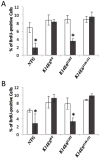Human papillomavirus type 16 E6 and E7 oncoproteins act synergistically to cause head and neck cancer in mice
- PMID: 20797753
- PMCID: PMC2946459
- DOI: 10.1016/j.virol.2010.08.003
Human papillomavirus type 16 E6 and E7 oncoproteins act synergistically to cause head and neck cancer in mice
Abstract
High-risk human papillomaviruses (HPVs) contribute to cervical and other anogenital cancers, and they are also linked etiologically to a subset of head and neck squamous cell carcinomas (HNSCC). We previously established a model for HPV-associated HNSCC in which we treated transgenic mice expressing the papillomaviral oncoproteins with the chemical carcinogen 4-nitroquinoline-1-oxide (4-NQO). We found that the HPV-16 E7 oncoprotein was highly potent in causing HNSCC, and its dominance masked any potential oncogenic contribution of E6, a second papillomaviral oncoprotein commonly expressed in human cancers. In the current study, we shortened the duration of treatment with 4-NQO to reduce the incidence of cancers and discovered a striking synergy between E6 and E7 in causing HNSCC. Comparing the oncogenic properties of wild-type versus mutant E6 genes in this model for HNSCC uncovered a role for some but not other cellular targets of E6 previously shown to contribute to cervical cancer.
Copyright © 2010 Elsevier Inc. All rights reserved.
Figures


Similar articles
-
Identification of biomarkers that distinguish human papillomavirus (HPV)-positive versus HPV-negative head and neck cancers in a mouse model.Proc Natl Acad Sci U S A. 2006 Sep 19;103(38):14152-7. doi: 10.1073/pnas.0606698103. Epub 2006 Sep 7. Proc Natl Acad Sci U S A. 2006. PMID: 16959885 Free PMC article.
-
Involvement of aryl hydrocarbon receptor signaling in the development of small cell lung cancer induced by HPV E6/E7 oncoproteins.J Transl Med. 2011 Jan 4;9:2. doi: 10.1186/1479-5876-9-2. J Transl Med. 2011. PMID: 21205295 Free PMC article.
-
ErbB-2 receptor cooperates with E6/E7 oncoproteins of HPV type 16 in breast tumorigenesis.Cell Cycle. 2007 Dec 1;6(23):2939-43. doi: 10.4161/cc.6.23.4949. Cell Cycle. 2007. PMID: 18156804
-
[Molecular basis of cervical carcinogenesis by high-risk human papillomaviruses].Uirusu. 2008 Dec;58(2):141-54. doi: 10.2222/jsv.58.141. Uirusu. 2008. PMID: 19374192 Review. Japanese.
-
HPV DNA, E6/E7 mRNA, and p16INK4a detection in head and neck cancers: a systematic review and meta-analysis.Lancet Oncol. 2014 Nov;15(12):1319-31. doi: 10.1016/S1470-2045(14)70471-1. Epub 2014 Oct 16. Lancet Oncol. 2014. PMID: 25439690
Cited by
-
Animal models to study the mutational landscape for oral cavity and oropharyngeal cancers.J Oral Maxillofac Res. 2013 Apr 1;4(1):e1. doi: 10.5037/jomr.2013.4101. J Oral Maxillofac Res. 2013. PMID: 24422024 Free PMC article. Review.
-
Biological basis for increased sensitivity to radiation therapy in HPV-positive head and neck cancers.Biomed Res Int. 2014;2014:696028. doi: 10.1155/2014/696028. Epub 2014 Apr 3. Biomed Res Int. 2014. PMID: 24804233 Free PMC article. Review.
-
DEK promotes HPV-positive and -negative head and neck cancer cell proliferation.Oncogene. 2015 Feb 12;34(7):868-77. doi: 10.1038/onc.2014.15. Epub 2014 Mar 10. Oncogene. 2015. PMID: 24608431 Free PMC article.
-
Biology of human papillomavirus infections in head and neck carcinogenesis.Head Neck Pathol. 2012 Jul;6 Suppl 1(Suppl 1):S3-15. doi: 10.1007/s12105-012-0367-2. Epub 2012 Jul 3. Head Neck Pathol. 2012. PMID: 22782219 Free PMC article. Review.
-
Human papillomavirus infections: warts or cancer?Cold Spring Harb Perspect Biol. 2013 Jul 1;5(7):a012997. doi: 10.1101/cshperspect.a012997. Cold Spring Harb Perspect Biol. 2013. PMID: 23685995 Free PMC article. Review.
References
-
- Balz V, Scheckenbach K, Gotte K, et al. Is the p53 inactivation frequency in squamous cell carcinomas of the head and neck underestimated? Analysis of p53 exons 2–11 and human papillomavirus 16/18 E6 transcripts in 123 unselected tumor specimens. Cancer Res. 2003;63 (6):1188–91. - PubMed
-
- Bilder D, Li M, Perrimon N. Cooperative regulation of cell polarity and growth by Drosophila tumor suppressors. Science. 2000;289 (5476):113–6. - PubMed
-
- Boyer SN, Wazer DE, Band V. E7 protein of human papilloma virus-16 induces degradation of retinoblastoma protein through the ubiquitin-proteasome pathway. Cancer Res. 1996;56 (20):4620–4. - PubMed
Publication types
MeSH terms
Substances
Grants and funding
LinkOut - more resources
Full Text Sources
Medical
Molecular Biology Databases

